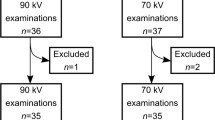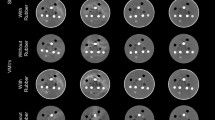Abstract
Background
Respiratory-related cardiac motion could have considerable effects on myocardial perfusion imaging, leading to misinterpretation of the images. In this study, we examined the influence of respiratory correction on ECG-gated myocardial perfusion SPECT (RC-GSPECT) concerning regional myocardial perfusion and function.
Materials and Methods
Using the NCAT phantom, a typical torso phantom was generated. SimSET, a Monte Carlo simulator, was used to image the photon emerging from the phantom. Twenty-six patients underwent a 2-day stress-rest ECG-gated myocardial perfusion SPECT (GSPECT) imaging. A separate study was also performed by simultaneous respiratory and cardiac triggering with the real-time position management (RPM) for respiratory correction (RC).
Results
In simulation study, count density in the inferior and inferoseptal walls increased in the lower bin of the respiratory cycle. On the other hand, there was a higher correlation between RC-GSPECT and echocardiography for left ventricular ejection fraction (LVEF) (r = 0.95, P < .01 vs r = 0.88, P < .01 for GSPECT).
Conclusion
We proposed a new approach for respiratory and cardiac-gated SPECT to eliminate respiratory motion artifacts. RC-GSPECT is a feasible method in MPI studies and may play an important role to improve the quality of MPI images, particularly in the inferior wall.









Similar content being viewed by others
References
Germano G, Erel J, Kiat H, Kavanagh PB, Berman DS. Quantitative LVEF and qualitative regional function from gated thallium-201 perfusion SPECT. J Nucl Med 1997;38:749-54.
Go V, Bhatt MR, Hendel RC. The diagnostic and prognostic value of ECG-gated SPECT myocardial perfusion imaging. J Nucl Med 2004;45:912-21.
Segars W, Sturgeon G, Mendonca S, Grimes J, Tsui B. 4D XCAT phantom for multimodality imaging research. Med Phys 2010;37:4902-15.
Redgate S, Barber DC, Abdallah A-M, Wendy TB. Using a registration-based motion correction algorithm to correct for respiratory motion during myocardial perfusion imaging. Nucl Med Commun 2013;34:787-95.
Pretorius PH, King MA, Tsui BM, LaCroix KJ, Xia W. A mathematical model of motion of the heart for use in generating source and attenuation maps for simulating emission imaging. Med Phys 1999;26:2323-32.
Reutter BW, Klein GJ, Huesman RH. Automated 3-D segmentation of respiratory-gated PET transmission images. IEEE Trans Nucl Sci 1997;44:2473-6.
McClelland J, Hawkes DJ, Schaeffter T, King AP. Respiratory motion models: A review. Med Image Anal 2013;17:19-42.
Pitman AG, Kalff V, Van Every B, Risa B, Barnden LR, Kelly MJ. Effect of mechanically simulated diaphragmatic respiratory motion on myocardial SPECT processed with and whitout attenuation correction. J Nucl Med 2002;43:1259-67.
Vedam SS, Keall PJ, Kini VR, Mostafavi H, Shukla HP, Mohan R. Acquiring a four-dimensional computed tomography dataset using an external respiratory signal. Phys Med Biol 2003;48:45-62.
Fredrickson JO, Wegmuller H, Herfkens RJ, Pelc NJ. Simultaneous temporal resolution of cardiac and respiratory motion in MR imaging. Radiology 1995;195:169-75.
Rahmim A, Tang J, Zaidi H. Four-dimensional image reconstruction strategies in cardiac-gated and respiratory-gated PET imaging. PET Clin 2013;8:51-67.
Polycarpou I, Tsoumpas C, King AP, Marsden PK. Impact of respiratory motion correction and spatial resolution on lesion detection in PET: A simulation study based on real MR dynamic data. Phys Med Biol 2014;59:697.
Pépin A, Daouk J, Bailly P, Hapdey S, Meyer M-E. Management of respiratory motion in PET/computed tomography: The state of the art. Nucl Med Commun 2014;35:113.
Darwesh RM, Shin E, Morgan PS, Perkins AC. Improved visualization of perfusion defects by respiratory-gated SPECT: A phantom simulation study. Nucl Med Commun 2014;35:189-96.
Sakaguchi K, Hosono M, Otsuka M, Hanaoka K, Usami K, Uto T, et al. Dynamic sequence respiratory gated perfusion pulmonary SPECT without external tracking device. Ann Nucl Med 2013;27:65-73.
Kovalski G, Israel O, Keidar Z, Frenkel A, Sachs J, Azhari H. Correction of heart motion due to respiration in clinical myocardial perfusion SPECT scans using respiratory gating. J Nucl Med 2007;48:630-6.
Beach RD, Pretorius PH, Boening G, Bruyant P, Feng B, Fulton R, et al. Feasibility of stereo-infrared tracking to monitor patient motion during cardiac SPECT imaging. IEEE Trans Nucl Sci 2004;51:2693-8.
Livieratos L, Stegger L, Bloomfield PM, Schafers K, Bailey DL, Camici PG. Rigid body transformation of list-mode projection data for respiratory motion correction in cardiac PET. Phys Med Biol 2005;50:3313-22.
Bland JM, Altman DG. Statistical methods for assessing agreement between two methods of clinical measurement. Lancet 1986;8:307-10.
Cho K, Kumiata S, Okada S, Kumazaki T. Development of respiratory gated myocardial SPECT system. J Nucl Cardiol 1999;6:20-8.
Vedam SS, Kini VR, Keall PJ, Ramakrishnan V, Mostafavi H, Mohan R. Quantifying the predictability of diaphragm motion during respiration with a noninvasive external marker. Med Phys 2003;30:505-13.
Nehrke K, Börnert P, Manke D, Böck JC. Free-breathing cardiac MR imaging: Study of implications of respiratory motion-initial results. Radiology 2001;220:810-5.
Pillay M, Cox PH, Schönfeld DHW, Mathews S. Tc-99m tetrofosmin myocardial distribution 4 hours post injection. Int J Cardiovasc Imaging 1996;12:127-35.
Zaret BL, Beller GA. Clinical nuclear cardiology: State of the art and further directions. 4th ed. Philadelphia: Mosby, Inc.; 2010.
Laarman G, Niemeyer MG, Van Der Wall EE, Verzijlbergen FJ, Bruschke AV, Ascoop CA. Dipyridamole thallium testing: Noncardiac side effects, cardiac effects, electrocardiographic changes and hemodynamic changes after dipyridamole infusion with or without exercise. Int J Cardiol 1988;20:231-8.
Botvinick EH, Dae MW. Dipyridamole perfusion scintigraphy. Semin Nucl Med 1991;21:242-65.
Lenz TL, Hilleman DE. Aggrenox: A fixed-dose combination of aspirin and dipyridamole. Ann Pharmacother 2000;34:1283-90.
Bruyant P, King MA, Pretorius PH. Correction of the respiratory motion of the heart by tracking of the center of mass of thresholded projections: A simulation study using the dynamic MCAT phantom. IEEE Trans Nucl Sci 2002;49:2159-66.
Slomka PJ, Nishina H, Abidov A, Hayes SW, Friedman JD, Berman DS, et al. Combined quantitative supine-prone myocardial perfusion SPECT improves detection of coronary artery disease and normalcy rates in women. J Nucl Cardiol 2007;14:44-52.
Könik A, Kikut J, Lew R, Johnson K, King MA. Comparison of methods of acquiring attenuation maps for cardiac SPECT in the presence of respiratory motion. J Nucl Cardiol 2013;20:1093-107.
Goetze S, Brown TL, Lavely WC, Zhang Z, Bengel FM. Attenuation correction in myocardial perfusion SPECT/CT: Effects of misregistration and value of reregistration. J Nucl Med 2007;48:1090-5.
Celler A, Dixon KL, Chang Z, Blinder S, Powe J, Harrop R. Problems created in attenuation-corrected SPECT images by artifacts in attenuation maps: A simulation study. J Nucl Med 2005;46:335-43.
Nakajima K, Higuchi T, Taki J, Kawano M, Tonami N. Accuracy of ventricular volume and ejection fraction measured by gated myocardial SPECT: Comparison of 4 software programs. J Nucl Med 2001;42:1571-8.
Hansen CL, Goldstein RA, Berman DS, Churchwell KB, Cooke D, Corbett JR, et al. Myocardial perfusion and function single photon emission computed tomography. J Nucl Cardiol 2006;13:97-120.
Acknowledgments
We would like to thank Dr Mona Heidarali in for assisting with scientific writing and submitting the manuscript. Also we thank the staff of cardiac electrophysiology research center for collaborating in preparing and consulting the manuscript.
Disclosure
There is no financial disclosure.
Author information
Authors and Affiliations
Corresponding author
Rights and permissions
About this article
Cite this article
Bitarafan-Rajabi, A., Rajabi, H., Rastgou, F. et al. Influence of respiratory motion correction on quantification of myocardial perfusion SPECT. J. Nucl. Cardiol. 22, 1019–1030 (2015). https://doi.org/10.1007/s12350-014-0031-1
Received:
Accepted:
Published:
Issue Date:
DOI: https://doi.org/10.1007/s12350-014-0031-1




